very operator knows that bigger trucks are more productive—but how
Page 26
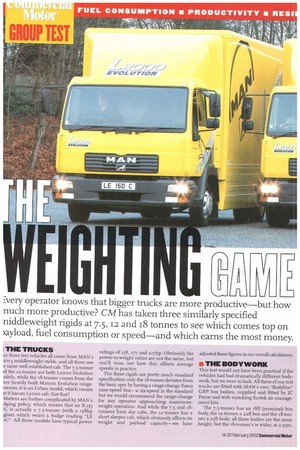
Page 27
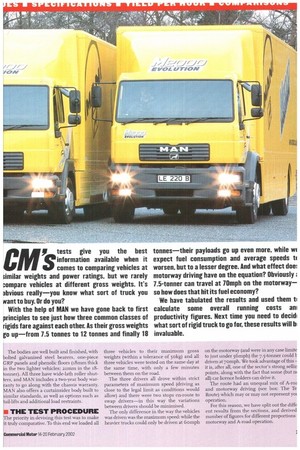
Page 28
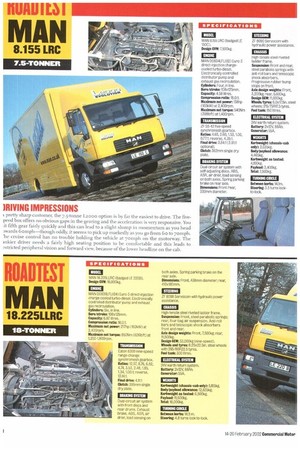
Page 29
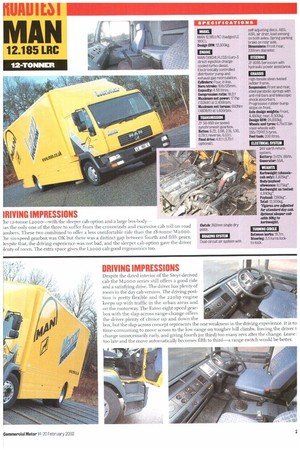
Page 30
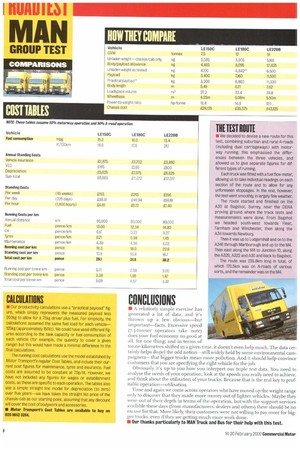
Page 31
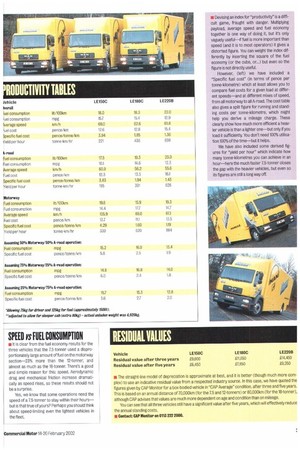
If you've noticed an error in this article please click here to report it so we can fix it.
nuch more productive? CM has taken three similarly specified niddleweight rigids at 7.5, 12 and 18 tonnes to see which comes top on myload, fuel consumption or speed—and which earns the most money.
M
C' gis tests m a give a vyaoi lua b i ethe w h e best t acomes to comparing vehicles at ilmilar weights and power ratings. but we rarely ompare vehicles at different gross weights. It's Anions really—you know what sort of truck you Nant to buy. Or do you?
With the help of MAN we have gone back to first principles to see just how three common classes of rigids fare against each other. As their gross weights go up—from 7.5 tonnes to 12 tonnes and finally 18 tonnes—their payloads go up even more, while wi expect fuel consumption and average speeds ti worsen, but to a lesser degree. And what effect doe! motorway driving have on the equation? Obviously ; 7.5-tonner can travel at lOmph on the motorway— so how does that hit its fuel economy?
We have tabulated the results and used them ti calculate some overall running costs ani productivity figures. Next time you need to decidi what sort of rigid truck to go for, these results will It invaluable.
THE TRUCKS
ir three test vehicles all come from MAN's iro-3 middleweight stable, and all three use e same well established cab. The 7.5-tonner d the 12-toriner are both L2000 Evolution odels, while the r8-tonner comes from the ore heavily built M2000 Evolution range. awever, it is an Urban model, which means at it has an 12000 cab. Got that?
Matters are further complicated by MAN's dging policy, which means that an 8.155 LC is actually a 7.5-tonner (with a 138hp gine) which wears a badge reading "LE DC". All three models have typical power
ratings 01138, 177 and 217hp. Obviously the power-to-weight ratios are not the same, but you'll soon see how this affects average speeds in practice.
The three rigids are pretty much standard specification: only the r8-tormer deviates from the basic spec by having a range-change Eaton nine-speed box—a six-speed is the standard but we would recommend the range-change for any operator approaching maximumweight operation. And while the 7.5 and 18tonners have day cabs, the 124onner has a short sleeper cab, which obviously affects its weight and payload capacity—we have adjusted these figures in our overall calculations.
• THE BODYWORK
This test would not have been practical if the vehicles had had dramatically different bodywork, but we were in luck. All three of our test trucks are fitted with MAN's own "Bodyline" GRP box bodies, supplied and fitted by JC Payne and with matching Ecotek air management kits.
The 7.5-tonner has an 18ft (nominal) box body, the 12-tonner a 22ft box and the r8-tonner a 25ft body; all three bodies are the same height, but the r8-tormer's is wider, at 2.55m.
The bodies are well built and finished, with Jolted galvanised steel bearers, one-piece RP panels and phenolic floors (18mm thick in the two lighter vehicles; 2IMM in the 18onner). All three have wide-lath roller shutiers, and MAN includes a two-year body waranty to go along with the chassis warranty.
AN also offers a curtainsider body built to imilar standards, as well as options such as ail-lifts and additional load restraints.
• THE TEST PROCEDURE
The priority in devising this test was to make it truly comparative. To this end we loaded all three vehicles to their maximum gross weights (within a tolerance of 50kg) and all three vehicles were tested on the same day at the same time, with only a few minutes between them on the road.
The three drivers all drove within strict parameters of maximum speed (driving as close to the legal limit as conditions would allow) and there were two stops en-route to swap drivers—in this way the variations between drivers should be minimised.
The only difference in the way the vehicles was driven was the maximum speed: while the heavier trucks could only be driven at 6omph on the motorway (and were in any case limitt to just under 56mph) the 7.5-tonner could t driven at 70mph. We took advantage of this it is, after all, one of the sector's strong sellir points, along with the fact that some (but ni all) car licence holders can drive it.
The route had an unequal mix of A-rm and motorway driving (see box: The Te Route) which may or may not represent yot operation.
For this reason, we have split out the diffc ent results from the sections, and derived number of figures for different proportions motorway and A-road operation.
MAN
8.155 LRC
7.5-TONNEIR
'RIVING IMPRESSIONS
s pretty sharp customer, the 7.5-tonne 1.2000 option is by far the easiest to drive. The fivepeed box offers no obvious gaps in the gearing and the acceleration is very responsive. You [it fifth gear fairly quickly and this can lead to a slight slump in momentum as you head )wards 6omph—though oddly, it seems to pick up markedly as you go from Go to 70mph. lie cruise control has no trouble holding the vehicle at 70niph on the motorway. The inkier driver needs a fairly high seating position to be comfortable and this leads to E..stric-ted peripheral vision and forward view, because of the lower headline on the cab.
SPECIFICATIONS MODEL MAN 8.155 LAC (badged LE 150C).
Design OW: 7,500kg.
ENGINE
MAN D083411L(02) Euro-3 direct-injection chargecooled turbo-diesel. Electronically controlled distributor pump and exhaust gas recirculation. Cylinders: Four, in line. Bere./stroke:108x125mm.
Capacity; 4.58 litres. Compression ratio:18.0:1. Maximum net power 138hp (103kW) at 2,400rpm. Maximum net torque: 540Nm (398Ibft) at 1,400rpm.
TRANSMISSION
ZF 55-42 five-speed synchromesh gearbox. Ratios: 4.65, 2.60,1.53,1.00, 0.77:1; reverse, 4.35:1. Final drive: 3.64:1(3.91:1 optional).
Clutch: 362mm single dry plate.
BRAKING SYSTEM
Dual-circuit air system with self-adjusting discs. ABS, ASR, air drier, load sensing on both axles. Spring parking brake on rear axle. Dimensions: Front/rear, 330mm diameter.
STEERING ZF 8090 Servocom with hydraulic power assistance.
CHASSIS High-tensile steel riveted ladder frame.
Suspension: Front and rear, steel parabolic springs with anti-roll bars and telescopic shock absorbers. Progressive rubber bump stops on front.
Axle design weights: Front, 3,200kg; rear, 5,600kg. Design GCW: it000kg. Wheels/tyres: 6.0x17.5in. steel wheels; 215/75R17.5 tyres. Fuel tank 150 litres.
ELECTRICAL SYSTEM
24V earth return system. Battery: 2x12V, 88Ah. Generator: 55A.
WEIGHTS
Kerbweight (chassis-cab only); 3,035kg. Body/payload allowance: 4,465kg. Korhweight as tested: ajookg.
Payload: 3,400kg.
Total: i7,500kg.
TURNING CIRCLE Between kerbs:14:1m. Steering:15 turns lankly: -lock.
ROADTEST
MAN
18.225LLRC
18-TONNER
SPECIFICATIONS MODEL MAN18.225LLRC (badged LE 2200). Design GlIW:18,000kg.
ENGINE
MAN D0836LFL(04) Euro-3 direct-injection charge-cooled turbo-diesel. Electronically controlled distributor pump and exhaust gas recirculation.
Cylinders: Six, in line. Bore/stroke:108x125mm.
Capacity: 6.87 litres.
Compression ratio: 18.0:1.
Maximum net power: 217hp (162kW) at 2,40Crpm.
Maximum net torque: 850Nm (6261bft) at 1,200-1,800rpm.
TRANSMISSION
Eaton 8309 nine-speed range-change synchromesh gearbox. Ratios: 12,57, 8.76,6.52, 4.74, 3.53, 2.48,1.85, 1.34,1.00; reverse, 13.14:1.
Final drive: 4.11:1
Clutch; 395mm single dry plate.
BRAKING SYSTEM
Dual-circuit air system with front discs and rear drums. Exhaust brake. ABS, ASR, air drier, load sensing on both axles. Spring parking brake on the rear axle.
Dhnenslont Front, 438mm diameter; rear, 410x180mm.
STEERING ZF 8098 Servocom with hydraulic power assistance.
CHASSIS
High-tensile steel riveted ladder frame. Suspension: Front, steel parabolic springs; rear, four-bag air suspension. Anti-roll bars and telescopic shock absorbers front and rear.
Axle design weights: Front, 7,500kg; rear, twokg.
Design GCW: 33,000kg (nine-speed).
Wheels and tyres: 8.25x22.5in. steel wheels with 295/80R22.5 tyres.
Fuel tank 340 litres.
ELECTRICAL SYSTEM
24V earth return system. Battery: 2x12V, Generator:55A.
WEIGHTS
Kerbweight (chassis-cab only): 5,165kg. Body/payload allowance: 12,835kg. Kerbweight as tested: 6,500kg. Payload: 11,500kg.
Total: 18,000kg.
TURNING CIRCLE
Between Icerbm 18.5 m. Steering: 4.8 turns lock-to-lock.
12-TONNER
'RIVING IMPRESSIONS
he i2-tonne L2000—with the sleeper cab option and a large box-body
ras the only one of the three to suffer from the crosswinds and excessive cab roll on road ambers. These two combined to offer a less comfortable ride than the r8-tonne M2000. 'he six-speed gearbox was OK but there was a distinct gap between fourth and fifth gears. )espite that, the driving experience was not bad, and the sleeper cab option gave the driver denty of room. The extra space gives the Lz000 cab good ergonomics too.
SPECIFICATIONS
MODEL MAN 12.185 LRC (badged LE 180C).
Design Mt 12,000kg.
ENGINE
MAN D0834LFL(03) Euro-3 direct-injection chargecooled turbo-diesel. Electronically controlled distributor pump and exhaust gas recirculation. Cylinders: Four, in line. Bore/stroke: 108x125mm. Capacity: 4.58 litres. Compression ratio:18.0:1 Maximum net power:177hp (132kW) at 2,400rpm. Maximum net torque: 650Nm (4801bft) at 1,400rpm.
TRANSMISSION
ZF S6-850 six-speed synchromesh gearbox. Ratios: 632, 3.68, 2.15,1.00. 0.79:1; reverse, 6.03:1. Final drive 4.11:1(3.70:1 optional).
Clutch: 362mm single dry plate.
BRAKING SYSTEM Dual-circuit air system with
self-adjusting discs. ABS, ASR, air drier, load sensing on both axles. Spring parking brake on rear axle. Dimensions: Front/rear, 330mm diameter,
STEERING ZF 8095 Servocom with hydraulic power assistance.
CHASSIS High-tensFle steel riveted ladder frame.
Suspension: Front and rear, steel parabolic springs with anti-roll bars and telescopic shock absorbers. Progressive rubber bump stops on front.
Axle design weights: Front, 4,450kg; rear, 8,500kg. Design GC W: 24,000kg. Wheels and tyres: 6.75x17.5in steel wheels with 265/70017.5 tyres.
Fuel tank 200 litres.
ELECTRICAL SYSTEM 24V earth return
Ilksystem. Battery: 2x12V, 88Ah. dt, Generator:55A.
VEIRIITS
Korbweight (chassiscab only): 3,825.tr. Body-payload allowance: 8,175kg`. Kerbweight as tested: Payload: 7.1E0kg'. Total:-2,a:',Okg. 'Figures are adjusted for standard day cab. Optional sleeper cab adds &Mg to kerbweight.
TURNING CIRCLE Between kerbs: 182m. Steerkig 3.5 turns lockto-lock.
DRIVING IMPRESSIONS
Despite the dated interior of the Steyr-derived cab the M2000 series still offers a good ride and a satisfying drive. The driver has plenty of room in the day cab version. The driving position is pretty flexible and the 220hp engine keeps up with traffic in the urban areas and on the motonvay. The Eaton eight-speed gearbox with the slap-across range-change offers the driver plenty of choice up and down the box, but the slap-across concept represents the one weakness in the driving experience. It is to, time-consuming to move across to the low range on tougher hill climbs, forcing the driver t, change unnecessarily early, and giving fourth (or third) too many revs after the change. Leave too late and the move automatically becomes fifth to third—a range switch would be better.
CALCULATIONS
• Our productivity calculations use a "practical payload" figure, which simply represents the measured payload less 200kg to allow for a 75kg driver plus fuel, For simplicity, the calculations assumed the same fuel load for each vehicle125kg (approximately 1501it). We could have used different figures according to the tank capacity or fuel consumption of each vehicle (for example, the quantity to cover a given range) but this would have made a minimal difference to the final calculations.
The running cost calculations use the model established by Motor Transport's regular Cost Tables, and include their current cost figures for maintenance, tyres and insurance. Fuel costs are assumed to be constant at 70p/lit. However, we have not included any figures for wages or establishment costs, as these are specific to each operation. The tables also use a simple straight line model for depreciation (to zero) over five years-we have taken the straight list price of the chassis-cab as our starting-point, assuming that any discount will cover the cost of bodywork and accessories.
• Motor Transport's Cost Tables are available to buy on 020 8652 3284.
TOE TEST ROUTE
• We decided to devise a new route for this test, combining suburban and rural A-roads (including dual carriageways) with motorway running; this emphasised the differences between the three vehicles, and allowed us to give separate figures for different types of running.
Each truck was fitted with a fuel flow meter, allowing us to take individual readings on each section of the route and to allow for any unforeseen stoppages. In the end, however, the test went smoothly, in largely fine weather.
The route started and finished on the A30 at Bagshot, Surrey, near the DERA proving ground where the track tests and measurements were done. From Bagshot we headed south-west towards Fleet, Farnham and Winchester, then along the A34 towards Newbury.
Then it was up to Ludgershall and on to the A346 through Marlborough and up to the M4. Then east along the M4 to Junction 10, along the A329, A322 and A30 and back to Bagshot.
The route was 235.8km long in total, of which 170.5km was on A-roads of various sorts, and the remainder was on the M4.
• Devising an index for "productivity" is a difficult game, fraught with danger. Multiplying payload, average speed and fuel economy together is one way of doing it, but it's only vaguely useful-if fuel is more important than speed (and it is to most operators) it gives a distorted figure. You can weight the index differently by inserting the square of the fuel economy (or the cube, or...) but even so the figure is not directly useful.
However, (left) we have included a "Specific fuel cost" (in terms of pence per tonne-kilometre) which at least allows you to compare fuel costs for a given load at different speeds-and at different mixes of speed, from all motorway to all A-road. The cost table also gives a split figure for running and standing costs per tonne-kilometre, which might help you derive a mileage charge. These clearly show how much more efficient a heavier vehicle is than a lighter one-but only if you load it sufficiently. You don't need 100% utilisation 100% of the time-but it helps.
We have also included some derived figures for "yield per hour" which indicate how many tonne-kilometres you can achieve in an hour-here the much faster 7.5-tonner closes the gap with the heavier vehicles, but even so its figures are still a long way oft
CONCLUSIONS
• A relatively simple exercise has generated a lot of data, arid it's thrown up a few obvious-but important-facts. Excessive speed (7.5-tonner operators take note) does your fuel economy no good at all, for one thing; and in terms of tonne-kilometres shifted in a given time, it doesn't even help much. The data certainly helps dispel the odd notion-still widely held by some environmental campaigners-that bigger trucks mean more pollution. And it should help convince customers that you are specifying the right vehicle for the job.
Obviously it's up to you how you interpret our triple test data. You need to analyse the needs of your operation, look at the speeds you really need to achieve, and think about the utilisation of your trucks. Because that is the real key to prof itable operation-utilisation.
Time and again we come across operators who have moved up the weight range only to discover that they made more money out of lighter vehicles. Maybe they were out of their depth in terms of the operation, but with the support services available these days (from manufacturers, dealers and others) there should be no excuse for that. More likely, their customers were not willing to pay more for bigger trucks, even if they are getting much more work done.
• Our thanks particularly to MAN Truck and Bus for their help with this test, SPEED vs FUEL CONSUMPTION Its clear from the fuel economy results for the three vehicles that the 7.5-tonner used a disproportionately large amount of fuel on the motorway section-23% more than the 12-tonner, and almost as much as the 18-tonner. There's a good and simple reason for this: speed. Aerodynamic drag and mechanical friction increase dramatically as speed rises, so these results should not be a surprise.
Yes, we know that some operations need the speed of a 7.5-tonner to stay within their hoursbut is that true of yours? Perhaps you should think about speed-limiting even the lightest vehicles in the fleet. • The straight-line model of depreciation is approximate at best, and it is better (though much more complex) to use an indicative residual value from a respected industry source. In this case, we have quoted the figures given by CAP Monitor for a box-bodied vehicle in "CAP Average" condition, after three and five years. This is based on an annual distance of 70,000km (for the 7.5 and 12-tonners) or 80,000km (for the 18-tonner) although CAP advises that values are much more dependent on age and condition than on mileage.
You can see that all three vehicles still have a significant value after five years, which will effectively reduce the annual standing costs.
• Contact CAP Monttor on 0115 222 2000.












































































































































